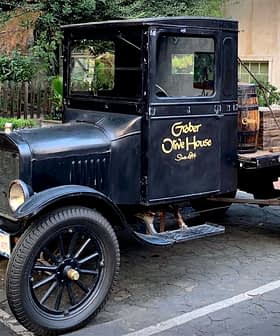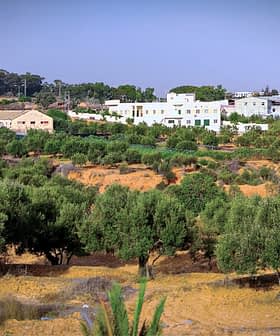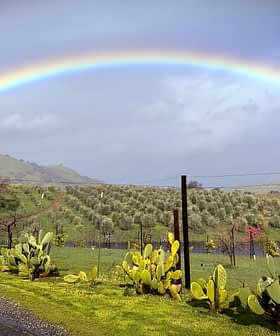California Olive Farmers Create Pollinator Habitats to Boost Biodiversity
Farmers are cultivating native plants to reverse the effects of climate change on beneficial insect and pollinator habitats.
California olive growers are using native plants to create habitats for beneficial insects and pollinators to combat the impacts of climate change. The Xerces Society for Invertebrate Conservation is providing climate-smart native plant kits to farmers in California to rebuild endemic habitats and increase biodiversity on farms, with potential benefits for plant and animal diversity, soil health, and water infiltration.
California olive growers are increasingly combating the impacts of climate change by cultivating native plants to create habitats for beneficial insects and pollinators.
Since the 1980s, the Western Monarch butterfly population has declined by more than 95 percent. More generally, insect pollinator populations have dropped, likely due to climate change, pesticides and habitat degradation.
Anything we can do to increase the population of native pollinators not only benefits the olives but a wide range of other agricultural crops.
The Xerces Society for Invertebrate Conservation is among the groups fighting against the decline in pollinators, providing climate-smart native plants to project partners.
Native habitat kits of more than 100,000 plants have already been provided to 144 farming partners in California between 2019 and 2021.
See Also:California Olive Farmers Embrace Regenerative Agriculture to Combat Climate Challenges“The Xerces habitat kits program in California matches people and places who want to plant and care for pollinator and beneficial insect habitat with transplants of native plants with high conservation value,” Stephanie Frischie, an agronomist for Xerces, told Olive Oil Times.
She added that the company provides technical assistance to farmers to make sure the solutions are long-term and sustainable. The company also helps farmers identify the most well-suited species to their particular location and source them locally to rebuild endemic habitats.
While Frischie advises farmers across Canada and the United States, Frischie said some of her earliest research focused on olive groves in Spain “through on-farm habitat research and projects, such as studying the suitability of native cover crops for olive orchards in Spain.”
“We found nearly a dozen high-priority species, and I worked with a native seed grower to develop the supply of those cover crop species,” Frischie added. “I continue to do this type of work in my role at the Xerces, increasing the seed supply of plants that are of high value to pollinators and other insects so more habitat can be created to add or enhance biodiversity on farms.”
In Yolo County, Temecula Olive Oil Company is the hub where farmers can pick up Xerces habitat kits.
“Even though olive trees evolved before the dawn of insects and do not need them for pollination – they are anemophilous [spreading pollen via the wind] – working with Xerces and creating more native pollinators is important for many reasons,” Thom Curry, the owner of Temecula Olive Oil Company, told Olive Oil Times.

Annas Hummingbird (Calypte anna)
“The most important benefits are plant and animal diversity,” he added. “A diverse community is much more resilient and healthy. Over time, our monocultural farming practices have had a detrimental effect on the diversity and, therefore, the overall biome health.”
In the San Joaquin Valley, Don Cameron, the vice president and general manager of Terranova Ranch, praised the kits. He said they helped him determine which pollinators would do well in his grove, taking some of the risk out of the investment.
“I believe that anything we can do to increase the population of native pollinators not only benefits the olives but a wide range of other agricultural crops that are dependent on insect pollination,” he told Olive Oil Times.
According to Frischie, climate-smart native plants have far-reaching benefits for farmers and producers.
“The habitat supports birds and other wildlife, adds to soil carbon and organic matter and can improve water infiltration and water storage capacity of the soil,” she said. “There are typically more than 12 species of plants in each kit, which also add colorful leaves and flowers to farmscapes.”
For olive farmers specifically, Frishie said that habitat kit also creates natural environments for predators of common olive pests.
“Cover crops and recovering native pollinator sites help improve the tilth of the soil and lessen the amount of outside inputs,” Curry added. “Studies also show that these practices also improve the amount of carbon sequestered by the olive grove.”
Farmers take different approaches to where to plant the kits.
“Depending on the farm, the habitat kits may be planted along field edges or in other places near the olive trees or other crops,” Frischie said. “For orchard species, cover crops in the lanes between tree rows are another way to add beneficial habitat to farms.”
“Not only is there a benefit to the native pollinators in the area by providing a food source,” Cameron added, “but for instance, in planting native pollinator hedgerows, we have seen other benefits, including erosion control in areas with slopes and sandier soils that maintain the integrity of our levees and roadsides.”
Some myths persist about native plants, pollination and restoration of insect habitats. For example, Curry said some people erroneously assume that European and Africanized honey bees are the only or most effective pollinators.
“These insects are interlopers and tend to push out native pollinators with the assistance of the human propagation of them,” he said. “Creating a stronger native pollinator population helps the native and non-native plants thrive much better.”
Some raise concerns that cultivating native plant habitats for pollinators in the olive groves could have side effects.
“There’s some concern that the habitat areas may lead to larger populations of rabbits, hares or other rodents that could damage crops or farm infrastructure, and snakes,” Frischie said. “I’m not aware of evidence that shows these beneficial insect plantings result in higher incidences of damage from these animals.”
She added that October and November are an opportune moment for olive growers statewide to find the suitable kit for them and begin planting.
“I am sure that it will become much more mainstream due to the efforts of Xerces and other such programs,” Curry said. “It seems that the practice is really taking off in the mainstream farming community.”
Cameron agreed. “I believe that by getting these kits out to olive growers, they will find similar attributes to what I have seen and will continue to invest in expanding projects on their farms to diversify habitats,” he concluded.
Share this article









